Mar 19, 2021
Thoughts on Pearson’s setback and Vladdy’s strong spring
The Blue Jays’ front office rightfully promotes their depth in numbers in potential starting pitchers, but the reality is that the options they have are unproven at the major-league level, Steve Phillips writes.
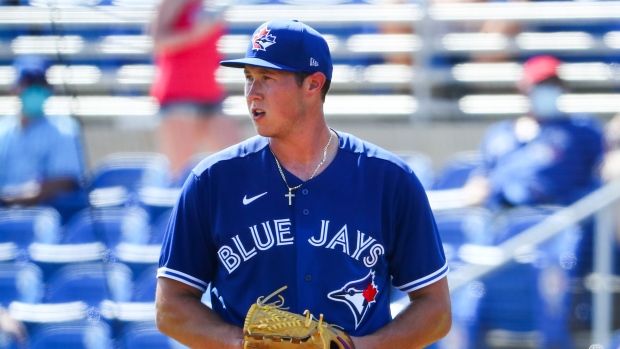
The Toronto Blue Jays pitching staff started spring training this year down at least one predictable starter, at least in my opinion.
They’ve lost key starter Nate Pearson to a right groin strain after he re-aggravated an injury that was first diagnosed following his spring training debut on March 1 during a bullpen session on Tuesday.
The injury to their top prospect spotlights how thin Toronto’s rotation is and how important a healthy and productive Pearson is to the Jays’ season, which opens in New York against the Yankees in less than two weeks.
Then on Wednesday, Thomas Hatch left his start in Dunedin, Fla., with elbow pain, further highlighting the issue.
The Jays’ front office rightfully promotes their depth in numbers in potential starting pitchers, but the reality is that the options they have are unproven at the major-league level.
The old baseball axiom that “you can never have enough pitching” holds true for the Jays, who are already being reminded of this before the 2021 season has even started.
There is a silver lining when it comes to Pearson, however. The 24-year-old was not going to be able to handle making 30 starts this season anyway. The Jays were going to have to manage his innings and workload to protect his arm from overuse.
He has only logged 163.2 innings during his four seasons in professional baseball. He threw only 20 of those innings in 2020 after missing five weeks with a right flexor strain during the COVID-19 pandemic-shortened season.
As a practice, teams rarely like to increase a pitcher’s innings from year-to-year by more than 20 per cent. The Jays have a bit more flexibility than the 20 per cent increase in Pearson’s case because of the reduced number of innings he tossed last season.
At any rate, it is unlikely that the Jays would push him much beyond 120 innings this season and that will still be reachable even with his delayed start to the season. They were going to have to back him off at some point anyhow. His injury is making the decision for them.
Pearson should be able to fully recover and get back to pitching, but the Jays will be conservative with his return as they want to make sure that his injury is fully healed.
The legs are the foundation of the pitching delivery and any attempt to compensate for an injury could cause different pressures on his elbow and shoulder. They don’t want his leg problem to become an arm problem.
Vladdy on the right track
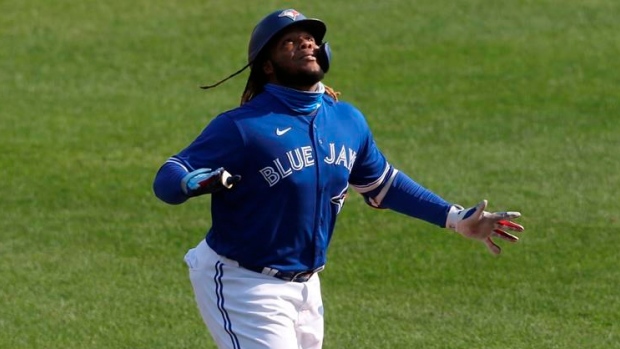
Vladimir Guerrero Jr. is swinging the bat very well this spring.
Analysts around the game expect this to be the year that the young slugger finally breaks out. It doesn’t really matter what the experts think, it really only matters what Vlad Jr. believes. He arrived at spring training in better shape and is focused for a big season.
Guerrero hasn’t been bad by any means. But he taught us to expect big things based upon his domination in the minor leagues (.331/.414/.531). He just hasn’t been the same hitter in the major leagues – at least not yet.
I really believe he lost a bit of confidence and the way it shows itself is in his plate discipline and his reduced launch angle (it dropped from about 11 degrees in the minors to 4.6 degrees in 2020).
When a hitter lacks confidence, he finds himself in between pitches. Bad thoughts equal bad timing. The batter is behind the fastball and in front of the off-speed pitches. It is where the mental part of the game affects the physical part of the game. This leads to more ground balls. This is where Vlad Jr. has found himself.
In the minor leagues, Guerrero walked more than he struck out (151 BB/139 SO). In the major leagues, he has only walked 66 times and struck out 129 times. I watched Guerrero hunt for fastballs in the minor leagues. I watched him set up a pitcher to get a certain pitch in a certain count and take advantage of it. He controlled the at-bats. So far in the major leagues, the pitchers have often manipulated him.
We will know that Vladimir Guerrero Jr. has figured it out when his walks and strikeouts even out. That will mean that he is seeing the ball and trusting his timing at the plate. He will swing at more strikes and find himself in more hitter’s counts (1-0, 2-0, 2-1, 3-1) where the next pitch is more predictable. That is when his contact-to-damage ratio will increase. So far this spring, he has walked more than he has struck out. That is a great sign of things to come.
Spitting Seeds
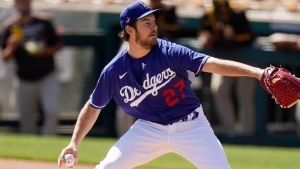 - Los Angeles Dodgers starting pitcher Trevor Bauer is at it again. He was warned by Major League Baseball about violating uniform regulations in a couple of spring training games. Bauer had corporate logos displayed on his T-shirt under his jersey and on his belt. The logo was of Bauer’s own personal brand. He responded by posting the warning letter on Twitter with pictures of him wearing his logoed gear. He also mocked baseball’s contention that the league can’t market players who don’t want to be marketed. And when he wanted to market himself, MLB said doing that is prohibited. This happened on the heels of Bauer pitching against the San Diego Padres in a spring training game with one eye closed. That’s right! He was throwing a weapon (the ball) 98 mph with one eye closed. He claimed that he likes to challenge himself while preparing for the season. In doing this, he made a mockery of the game, put the opposition at risk, and put his manager and general manager in a tough spot to have to defend his silliness. Getting paid $40 million a year, you would think that a player would be focused and determined and on his best behaviour. Blue Jays fans will be glad that he signed with another team during the off-season.
- Los Angeles Dodgers starting pitcher Trevor Bauer is at it again. He was warned by Major League Baseball about violating uniform regulations in a couple of spring training games. Bauer had corporate logos displayed on his T-shirt under his jersey and on his belt. The logo was of Bauer’s own personal brand. He responded by posting the warning letter on Twitter with pictures of him wearing his logoed gear. He also mocked baseball’s contention that the league can’t market players who don’t want to be marketed. And when he wanted to market himself, MLB said doing that is prohibited. This happened on the heels of Bauer pitching against the San Diego Padres in a spring training game with one eye closed. That’s right! He was throwing a weapon (the ball) 98 mph with one eye closed. He claimed that he likes to challenge himself while preparing for the season. In doing this, he made a mockery of the game, put the opposition at risk, and put his manager and general manager in a tough spot to have to defend his silliness. Getting paid $40 million a year, you would think that a player would be focused and determined and on his best behaviour. Blue Jays fans will be glad that he signed with another team during the off-season.
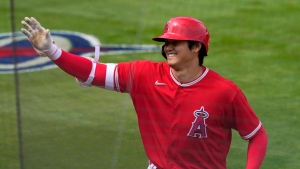 - Shohei Ohtani, the two-way star of the Los Angeles Angels, appears to be ready to be an elite performer as a pitcher and hitter. This spring he hit a home run over the 30-foot batters’ eye in centre field, which is 420 feet away from home plate. The homer was estimated to have travelled 467 feet. He has also delivered a number of pitches at 100 mph this spring. He is as talented and athletic a player as there has ever been in baseball and it seems like the Angels are going to be more aggressive in their use of him. In the past, Ohtani would make only one start a week on a designated day. This year, he will be part of a six-man rotation and will take the ball whenever his day falls. In the past, he would not act as the designated hitter the day before and after his starts. This year, the club is strongly considering his hitting on those days. He is too good to leave out of the lineup. They will have to manage his health and well-being because his workload will be more demanding. He will be an MVP candidate if his body holds up over the 162-game season.
- Shohei Ohtani, the two-way star of the Los Angeles Angels, appears to be ready to be an elite performer as a pitcher and hitter. This spring he hit a home run over the 30-foot batters’ eye in centre field, which is 420 feet away from home plate. The homer was estimated to have travelled 467 feet. He has also delivered a number of pitches at 100 mph this spring. He is as talented and athletic a player as there has ever been in baseball and it seems like the Angels are going to be more aggressive in their use of him. In the past, Ohtani would make only one start a week on a designated day. This year, he will be part of a six-man rotation and will take the ball whenever his day falls. In the past, he would not act as the designated hitter the day before and after his starts. This year, the club is strongly considering his hitting on those days. He is too good to leave out of the lineup. They will have to manage his health and well-being because his workload will be more demanding. He will be an MVP candidate if his body holds up over the 162-game season.
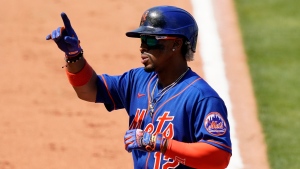 - Over the past 20 to 30 years, it has felt like the American League was the Varsity and the National League was the Junior Varsity. The “arms race” between the Yankees and Red Sox pulled everyone else along in the AL. Teams felt compelled to keep pace. But over the past couple of seasons, the NL has lured some AL talent by trade or free agency. The junior circuit, as the American League is called, was formed 25 years after the National League was formed, so it really is the junior circuit. Francisco Lindor, Carlos Carrasco, Charlie Morton, Marcus Stroman, James McCann, Trevor Bauer, Mookie Betts, Jackie Bradley Jr, Manny Machado and Blake Snell have all moved over from the AL to the NL. The AL has gone 25-6-1 over the last 32 All Star games. Look for the pendulum to swing the other way in the Midsummer Classic.
- Over the past 20 to 30 years, it has felt like the American League was the Varsity and the National League was the Junior Varsity. The “arms race” between the Yankees and Red Sox pulled everyone else along in the AL. Teams felt compelled to keep pace. But over the past couple of seasons, the NL has lured some AL talent by trade or free agency. The junior circuit, as the American League is called, was formed 25 years after the National League was formed, so it really is the junior circuit. Francisco Lindor, Carlos Carrasco, Charlie Morton, Marcus Stroman, James McCann, Trevor Bauer, Mookie Betts, Jackie Bradley Jr, Manny Machado and Blake Snell have all moved over from the AL to the NL. The AL has gone 25-6-1 over the last 32 All Star games. Look for the pendulum to swing the other way in the Midsummer Classic.

